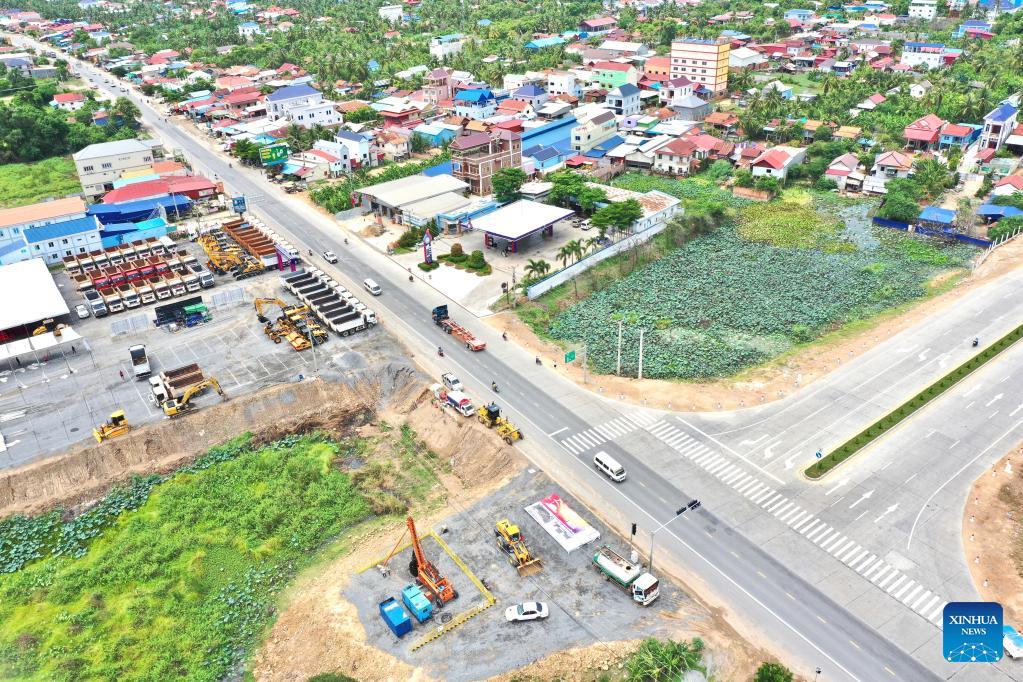BRI lifts China-Cambodia cooperation to new heights
- ?By Hannan R. Hussain
 0 Comment(s)
0 Comment(s) Print
Print E-mail China.org.cn, June 14, 2023
E-mail China.org.cn, June 14, 2023

This aerial photo taken on June 5, 2023 shows the construction site of Phnom Penh-Bavet Expressway, the kingdom's second Chinese-invested expressway, in Kandal province, Cambodia. [Photo/Xinhua]
Since joining China's Belt and Road Initiative (BRI), Cambodia has witnessed vital advancements in its infrastructure development and investment capacities to spur long-term progression. Dozens of factories now stand accommodated under Cambodia's largest industrial zone, while thousands of BRI-supported jobs further economic mobility and tangible benefits for swathes of populations. The initiative also forms an important component of Cambodia's long-term aspirations to emerge as an upper-middle-income country by 2030 and as a high-income country in 2050, underscoring a common vision.
The latest example of win-win BRI progress was the groundbreaking for the Phnom Penh-Bavet Expressway, a key connectivity project that links the Cambodian capital with the Bavet town border with Vietnam. As the second China-funded expressway in the kingdom, it underlines the importance of mutually beneficial BRI cooperation in supporting Cambodia's domestic infrastructure capacity needs.
From the Phnom Penh-Sihanoukville Expressway to the Siem Reap-Angkor International Airport, smooth BRI cooperation has a rich history of success in the kingdom. Mega projects have played a substantive role in furthering Cambodia's push toward high-quality development and connectivity ambitions, evidenced by thousands of kilometers of developed roads and bridges.
Under the BRI framework, China's support for Cambodia's infrastructure financing also remains ironclad. Beijing continues to allow substantial flexibility as opposed to any stringent international lending conditions. Such a sense of facilitation continues to contribute to the wider development vision of the kingdom, including through active BRI contributions to the Asian Highway Network project. "Cambodia is one of the countries that have benefited from China's Belt and Road Initiative," said Prime Minister Samdech Techo Hun Sen at the recent groundbreaking. "Through the BRI, Cambodia has received a great amount of grant aid, concessional loans, and investments from China for infrastructure development."
As a massive regional upside, key BRI projects also closely align with ASEAN's modernization drive, giving more strategic weight to international road networks connecting Cambodia. After all, BRI investment struck $30 billion since 2013 in the region, illustrating the importance of developing sprawling transportation links around Cambodia.
It is a fact that the two China-invested expressways stand to deepen Phnom Penh's trade and integration stakes in the lucrative "Indochina Peninsula" region. It is seen as a major point of convergence between China and ASEAN on future economic growth. Cambodia's involvement in that vision strengthens the case for future BRI traction in the kingdom. Scaled-up trade and economic mobility benefits have already delivered a lasting impact on the development of other ASEAN states in Cambodia's neighborhood, strengthening future prospects. As Prime Minister Hun Sen indicated recently, the BRI serves the interests of peace and development, doesn't threaten any other nation, and is well-aligned with ASEAN's centrality.
Without a doubt, the BRI has made enormous contributions to broadening the ambit of two-way trade between China and Cambodia as well. For 11 years straight, China has served as Cambodia's largest trading partner, with bilateral trade value hitting a record-setting $16.02 billion sum last year. More importantly, Phnom Penh's staunch advocacy for accelerated BRI progress has struck a common chord with China. Both partners feel empowered to prioritize speedy BRI implementation and untapped trade progress in tandem. A case in point is the top-level exchange between the leaders of the two countries early last year and the announcement of a host of new BRI connectivity projects around Cambodia at the 2022 ASEAN Summit.
As a result, win-win BRI cooperation makes a pivotal contribution to China and Cambodia's shared vision of sprawling transportation networks in the heart of Southeast Asia. Beijing's generous support for the kingdom's infrastructure development needs and capacities opens up new connectivity possibilities, especially by leveraging its unique strategic location in the heart of a high-growth region.
Hannan R. Hussain is a foreign affairs commentator, author and recipient of the Fulbright Award.
Opinion articles reflect the views of their authors, not necessarily those of China.org.cn.
If you would like to contribute, please contact us at opinion@china.org.cn.





